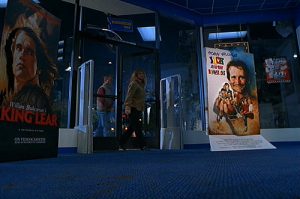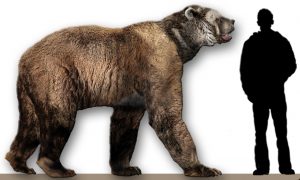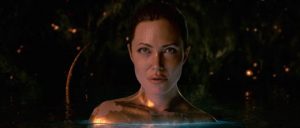
Since its release in 1997, The Lost World has long left fans speculating about pressing questions left unanswered by the film. Was John Hammond just trolling the whole time? Can a Velociraptor really be defeated with gymnastics? Most importantly, what was up with that poster for King Lear starring Arnold Schwarzenegger? The film being advertised does not exist. Not outside of The Lost World, anyway. It is a fabrication, something created specifically to be referenced in The Lost World.
Appearing alongside an equally fake poster of Jack and the Beanstalk starring Robin Williams (not to be confused with Jack, the 1996 movie starring Robin Williams), King Lear appears to be an adaptation of Shakespeare’s tragic play of the same name. But why this play in particular? Does it hold any significance to the plot and themes of The Lost World? The answer is more complicated than a simple “yes” or “no.”
It should be noted that drawing comparisons between popular media and Shakespeare’s plays has always been trendy, whether warranted or not. Many films are strongly or loosely based on Shakespeare’s plays, or at least contain specific Shakespearean elements. West Side Story, for example, is explicitly inspired by Romeo and Juliet, yet many films that feature similar plot threads of “star-crossed lovers” and feuding families do NOT draw from this play throughout their entire run time, instead opting to carry over the relationship dynamic and nothing else.

Having penetrated culture to an outstanding degree, references to Shakespeare are nearly as prominent as callbacks to religious texts, and the playwright’s work is (colloquially) synonymous with all things old and English. There is debate as to Shakespeare’s relevance as a subject of study: there is no denying his influence, of course, but the focus on his work tends to distract from his similarly prolific contemporaries, including Marlowe, Spenser, and . . . well, the hundreds and hundreds of non-European poets who have been largely ignored in favour of a Shakespeare-centric post-secondary syllabus.
The canon of English literature is largely a feedback loop in the same way modern Hollywood is self-perpetuating. It is easy to accept Marvel films as being exemplary of current film trends- because they are– but also because we are told that they are. Disney is very much capable of growing their influence by emphasizing their own popularity. More money means more marketing means more money, and so on. Having enough capital to influence a franchise’s perceived popularity results in actualized popularity, which is why it’s easier to be nostalgic for films like The Lion King and Beauty and the Beast than Disney’s less known properties . . . The Black Cauldron and Treasure Planet, for example. It’s less about how well-received these franchises were during their release and more about how lucrative they ended up being in the long term, which was indeed largely influenced by how much Disney chose to promote them. This principle extends to Shakespeare. You’ve probably seen adaptations of Hamlet or Romeo and Juliet, or at least know some famous lines, whereas Troilus and Cressida or The Winter’s Tale may feel less familiar, less accessible, even. They are distant from popular culture, and distant from consumers.

Orson Welles stated that, “Now we sit through Shakespeare in order to recognize the quotations,” revealing another aspect of the proliferation of specific media over similar works. Memeification, or the spread of ideas as a kind of in-joke, is an enormous contributing factor in a work’s popularity. This is why you can pick out iconic quotes from the balcony scene of Romeo and Juliet while not remembering other exchanges, or why if you have heard of The Winter’s Tale, it’s probably because of an infamous ursine stage direction. The quotability of lines and the recognizability of images determine the longevity of a work in popular culture. The Battleship Potemkin, though it holds up in many regards, is iconic because of the Odessa Steps sequence, and references to this one scene in later films sent audiences back to the original work, even if out of curiosity alone. Applying this same logic to Jurassic Park, you can see why lines like, “Life finds a way,” are more easily traced to their origin than, “Small versions of adults, honey.” One of these phrases has been framed as an iconic moment in the film, and the other has not.
The purpose of recognizing the role of memeification in media is to acknowledge the inherent flaw in making ties between The Lost World and King Lear. One would be inclined to select relevant plot points (Malcolm has three kids!) while ignoring the counter-evidence (Kelly is not executed . . .), all the while dissolving the plots of both works into chunks of easily-comparable bullet points, rather than examining the overarching themes. In order to link itself to a Shakespearean play, a work must either take on major plots elements (The Lion King and Hamlet) or bear thematic similarities to the original story (The Lion King and Henry IV: Part One). Godard’s King Lear (Lord have mercy on our souls!) for example, is not a direct adaptation of the work, but it repeatedly references the play as being canonically existent in the film’s universe (similar to the easter egg in The Lost World), yet it also comments on themes of communication and language, which are present in the original King Lear. Certainly, elements of The Lost World echo this message, with the primary conflict arising because of an inability/unwillingness of several characters to express their relationships clearly- Ian isn’t honest with Sarah, Kelly and Ian are not honest with each other- but their stories do not end in tragedy, and their interpersonal conflicts are neatly resolved by the end of the film. One might be inclined to draw comparisons between Hammond and Lear, two powerful men who disrupt the natural hierarchy of their kingdoms by dividing power among many factions, but once again, Hammond’s actions result in the continued stability of his domain, and it is explicitly stated in the closing monologue that his lack of interference is what’s best for the island. Lear, on the other hand, causes devastation by stepping down from his role as king, which is seen as the natural state of being. Shakespeare’s plays often focus on the role of monarchies in maintaining the “desired state” of a kingdom: Macbeth murdering Duncan disrupts the political sphere, Hamlet’s indecision leads to similar devastation, and- Well, it is assumed that in nearly every case, there is One True King who must take on the burden of leadership, because of bloodlines or destiny or what have you. This seems to go against the themes of The Lost World, which are largely anti-interventionist.
However . . .
Another film comes to mind when analyzing the themes of King Lear, one whose story is largely centered around the displacement of a natural-born ruler by an opposing force that is designed to take on a hierarchical role, which it abuses, feeding its lust for power by engaging in excessive and uncontrolled violence, only to be then overthrown by the original ruler who stands victorious over her domain while letting out a triumphant roar- Jurassic World is basically Shakespeare, is what I’m saying.

But is it, really?
Can anything be Shakespeare, other than Shakespeare’s plays themselves?
Let’s take a look at The Taming of the Shrew, a Shakespeare play that you’ve probably heard of, but know nothing about. The plot recounts a man’s attempts to psychologically manipulate a “shrewish” woman into becoming an obedient, unquestioning wife-figure, to the point where she will call the sun “the moon” if her . . . “mentor” instructs her to do so. This is-
Well, this is why it’s not a very popular play.
And yet, Shrew has not been forgotten nor entirely forsaken. The Woman’s Prize was written as a sequel/refutation of Shrew, in a kind of proto-every-book-written-by-Gregory-Maguire retelling of a distinctly hegemony-affirming narrative. And Shrew itself is often re-interpreted to be critical of Petruchio’s actions, if only in the actors’ deliveries. The work can be viewed through two lenses: what we see in it from a modern perspective, and what was most likely the author’s intended framing. And sometimes, it’s difficult to separate the two. Did the author(s) of Beowulf mean to frame Beowulf’s recounting of the swimming contest as entirely truthful, or as a boastful fabrication? The 2007 animated film implies the latter, though it is neither confirmed nor denied in the original poem. If it was discovered that the intent was to present the sea monster battle as entirely factual, does this make the subversion of this plot point a clever reframing or an affront to artistic intent? Perhaps both. Modern audiences might be unaware of this change, confusing adaptational differences with the worldview of the poem’s original listeners. They might take for granted that this was a decision made by the film’s creator, as was the casting of a CGI Angelina Jolie as the seductive snake-woman, who in the original poem was certainly not a love interest to any character, but rather, a hideous monster like her son. But even this interpretation is debatable. Being an ancient text, Beowulf’s authenticity can be questioned in certain respects. There is evidence to suggest that it is not an original manuscript, that it was edited over time, that it was based on ever-changing oral folktales, that it was a shoddy translation . . . and the list goes on.

Consider the relationship between Carnosaur and Jurassic Park: the novel Carnosaur predates the novel Jurassic Park, but the film Carnosaur sought to replicate or ride the success of the film Jurassic Park. Furthermore, neither film existed in a bubble. It is perhaps likely that there was communication between Laura Dern and her mother, Diane Ladd, both interested in how each other’s dinosaur-based films were coming along, to which Laura Dern might respond that she had completed the scene where she discusses the power of genetic engineering with a group of scientists, Diane Ladd nodding blankly as she has flashbacks to the scene where she pulls apart her belly with her bare hands to help birth a dinosaur that she implanted in her uterus to destroy humanity.

Point being, no work is wholly its own.
Much has been said about the fluidity of media, both intertextually and intratextually. How does one explain to a casual filmgoer that the new Star Wars standalone film makes reference to a discrepancy between two edits of the same motion picture, which became infamous for changing a smuggler’s initial characterization by digitally moving his head to the side by a few pixels, leading to years of snarky t-shirts and heated debates? “Han Shot First,” is not a reference to a specific film, per se, but rather, two versions of the same film that are even now competing for canonicity, judging by whether you side with the director’s vision concurrent to the original film’s release, or how that same director chose to evolve his intent.
Is King Lear a random easter egg with no textual significance, or was it chosen deliberately? The film does not provide any indication as to which is true. Whereas it’s fairly accepted that the creators of The Lion King were drawing from elements of Hamlet, and that Twilight (Yes, I know. Bear with me.) keeps quoting Romeo and Juliet for some reason, a brief glimpse of a fake movie poster is less explicitly intertextual. Actually, it is as intertextual as any other example of intertextuality, but the purpose and meaning is up for debate. There’s no way to tell if it’s a tongue-in-cheek joke, a subtle commentary on the plot, or a meaningless fabrication designed to fill background space. Unless we track down whoever came up with this easter egg, the author’s intent remains obscure, inaccessible through the work alone. The relationship between art and artist- another contentious topic- is significant in how one chooses to analyze this tidbit. If, for example, Spielberg came out and confirmed that it was his intent to draw parallels between King Lear and The Lost World, it would have a significantly different effect than a crew member confirming that he made the poster in his first year Photoshop class and decided to throw it into the background of the scene. Either way, someone created the poster. The advertisement depicts a film that does not exist. Unlike the reference to JAWS in Jurassic Park (taken as a nod to Spielberg), this make-believe motion picture has no real-world context, except that it combines a famous actor and a famous play, not unlike its counterpart on the opposite side of the frame.
Is THIS the joke? Maybe. But if that were the case, why not go the full mile and present the most ridiculous combination possible (Pitch: Hulk Hogan in a futuristic retelling of Jane Eyre)? And perhaps it should be noted that the mock-advertisements make reference to public domain works, which may indicate some legal motivation, but would it not be advisable to then also use fake celebrities instead of actual likenesses?
And the speculation continues.
The purpose of the King Lear poster in The Lost World remains a mystery, but this ambiguity is fruitful. Throughout this analysis, we have moved from questions of adaptation to artistic intent to intertextuality to authorship to legality, and so on. The sheer range of possibilities is astounding, and they all arose from the fact that the poster itself was not explained in-universe. The act of leaving minor details unaddressed engages the audience, whereas imposing a single interpretation on viewers may hinder their ability to speculate, wild and improbable as their theories may be. It is just as much the lack of information as it is the information itself that appeals to the analytically-inclined. It may be entertaining to reassemble a jigsaw puzzle, but removing pieces allows the audience to both assemble what has been put in place by the artist, and also guess what may be absent from the honeycombed image. The emptiness is not nothing; it is anything. It can be filled with any thought or idea that the human brain is capable of conjuring, and no single answer can be put forward with complete certainty, meaning the plurality of interpretations will forever be in flux, evolving with audiences, cultures, and all other facets of interpretation.
To answer the question of whether or not The Lost World bears any similarity to King Lear: it does and it doesn’t, and these diametrically opposed conclusions coexist while remaining in conflict.
There are no universal truths.
Only Universal’s King Lear.

